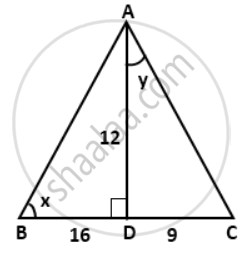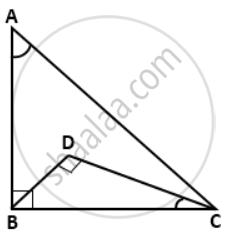Advertisements
Advertisements
प्रश्न
If 4sinθ = `sqrt(13)`, find the value of 4sin3θ - 3sinθ
उत्तर

Consider ΔABC, where ∠B = 90°
⇒ 4sinθ = `sqrt(13)`
⇒ 4sinθ = `sqrt(13)/(4)`
⇒ sinθ = `"Perpendicular"/"Hypotenuse" = "BC"/"AC" = sqrt(13)/(4)`
By Pythagoras theorem,
AC2 = AB2 + BC2
⇒ AB2
= AC2 - BC2
= `4^2 - (sqrt(13))^2`
= 16 - 13
= 3
⇒ AB = `sqrt(3)`
Now,
cosθ = `"Base"/"Hypotenuse" = "AB"/"AC" = sqrt(3)/(4)`
4sin3θ - 3sinθ
= `4(sqrt(13)/4)^3 - 3 xx sqrt(13)/(4)`
= `(13sqrt(13))/(16) - (3sqrt(13))/(4)`
= `(13sqrt(13) - 12sqrt(13))/(16)`
= `sqrt(13)/(16)`.
APPEARS IN
संबंधित प्रश्न
In the given figure, AD is perpendicular to BC. Find: 5 cos x
In a right-angled triangle ABC, ∠B = 90°, BD = 3, DC = 4, and AC = 13. A point D is inside the triangle such as ∠BDC = 90°.
Find the values of 2 tan ∠BAC - sin ∠BCD
If 24cosθ = 7 sinθ, find sinθ + cosθ.
If 8tanA = 15, find sinA - cosA.
If 3cosθ - 4sinθ = 2cosθ + sinθ, find tanθ.
If 4sinθ = `sqrt(13)`, find the value of `(4sinθ - 3cosθ)/(2sinθ + 6cosθ)`
If 5tanθ = 12, find the value of `(2sinθ - 3cosθ)/(4sinθ - 9cosθ)`.
If b tanθ = a, find the values of `(cosθ + sinθ)/(cosθ - sinθ)`.
If 12cosecθ = 13, find the value of `(sin^2θ - cos^2θ) /(2sinθ cosθ) xx (1)/tan^2θ`.
If secA = `(17)/(8)`, verify that `(3 - 4sin^2 "A")/(4 cos^2 "A" - 3)= (3 - tan^2"A")/(1 - 3tan^2"A")`
